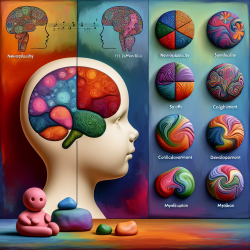Introduction
As a practitioner working with children, understanding the intricacies of brain development is crucial. A recent study titled "Individual differences in T1w/T2w ratio development during childhood" sheds light on how T1w/T2w ratios can serve as a proxy for cortical microstructure and neuroplasticity. This research provides insights into the age-related changes in brain development and highlights the importance of considering individual differences when planning interventions.
Understanding T1w/T2w Ratios
The T1w/T2w ratio is derived from MRI scans and is used as a measure of cortical microstructure, including myelination. Myelination is essential for efficient information transfer in the brain and plays a role in stabilizing brain networks. This stabilization can limit neuroplasticity, which is the brain's ability to change in response to experiences.
The study explored how T1w/T2w ratios vary with age in children aged 4-10. It found that these ratios are positively associated with age, particularly in sensorimotor and attention regions. This suggests that as children grow, their brains undergo significant structural changes that could impact learning and cognitive development.
Key Findings and Implications for Practice
- Age-Related Changes: The study confirmed that T1w/T2w ratios increase with age, indicating ongoing myelination and cortical development. Practitioners should consider age-specific interventions that align with these developmental changes.
- Socioeconomic Status (SES): Interestingly, the study did not find significant associations between T1w/T2w ratios and SES, cognition, or biological age. This highlights the complexity of brain development and suggests that SES-related differences may emerge later or require larger sample sizes to detect.
- Intervention Timing: Understanding the developmental trajectory of T1w/T2w ratios can help optimize the timing of educational and neuropsychological interventions. Early interventions can be tailored to leverage periods of high neuroplasticity.
Encouraging Further Research
While this study provides valuable insights, it also raises questions about the factors influencing T1w/T2w ratios and their implications for cognitive development. Practitioners are encouraged to stay informed about ongoing research in this area and consider participating in studies to contribute to the growing body of knowledge.
Further research could explore the impact of environmental factors, such as stress and enrichment, on T1w/T2w ratios. Longitudinal studies could also provide more detailed insights into how these ratios change over time and their relationship with learning and mental health outcomes.
Conclusion
Understanding the role of T1w/T2w ratios in brain development is essential for practitioners working with children. By incorporating these insights into practice, professionals can better support the cognitive and emotional development of their young clients. To delve deeper into the original research, please follow this link: Individual differences in T1w/T2w ratio development during childhood.










